University of Sunderland CET300 Project: Analysis of Reading Tutor
VerifiedAdded on 2023/01/19
|14
|4219
|71
Project
AI Summary
This project analyzes the development of a "Reading Tutor" mobile application, focusing on the analysis phase. It begins with an introduction highlighting the increasing use of mobile phones among children and its impact on educational apps. The assignment details the requirements gathering process, including client proposals, research into existing applications, and client meetings. It then delves into requirements analysis using PACT analysis and heuristic evaluation to determine user expectations. The project further specifies functional and non-functional requirements, user experience requirements, and agile user stories. It also includes a use case diagram, hardware and software requirements, and implementation guidelines. The analysis covers various aspects of the project, from data collection methods to detailed specifications, ensuring a comprehensive understanding of the application's design and development. The document includes detailed analysis, requirements specifications, and design considerations for a reading tutor app, and is contributed to Desklib to help students.
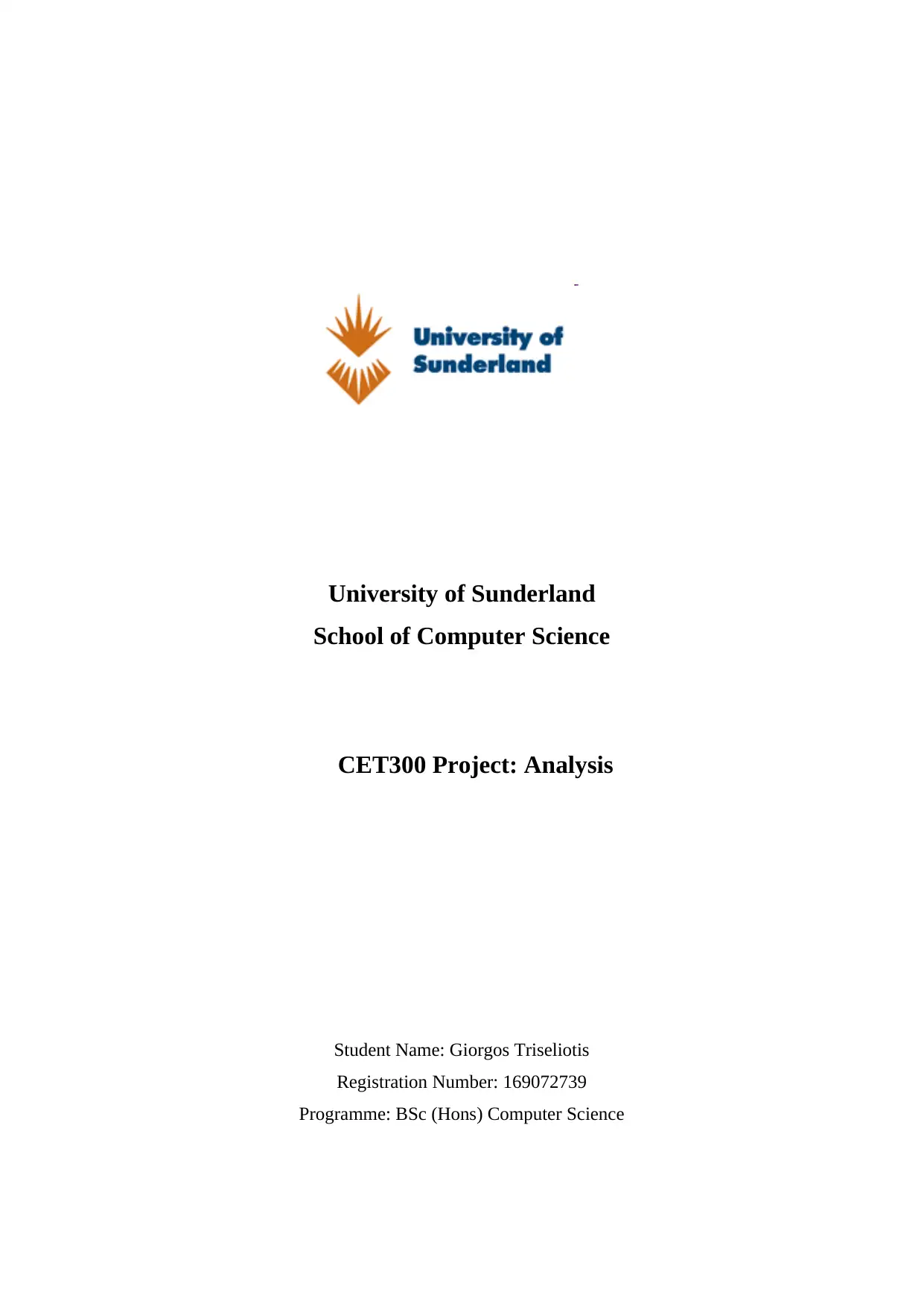
University of Sunderland
School of Computer Science
CET300 Project: Analysis
Student Name: Giorgos Triseliotis
Registration Number: 169072739
Programme: BSc (Hons) Computer Science
School of Computer Science
CET300 Project: Analysis
Student Name: Giorgos Triseliotis
Registration Number: 169072739
Programme: BSc (Hons) Computer Science
Paraphrase This Document
Need a fresh take? Get an instant paraphrase of this document with our AI Paraphraser
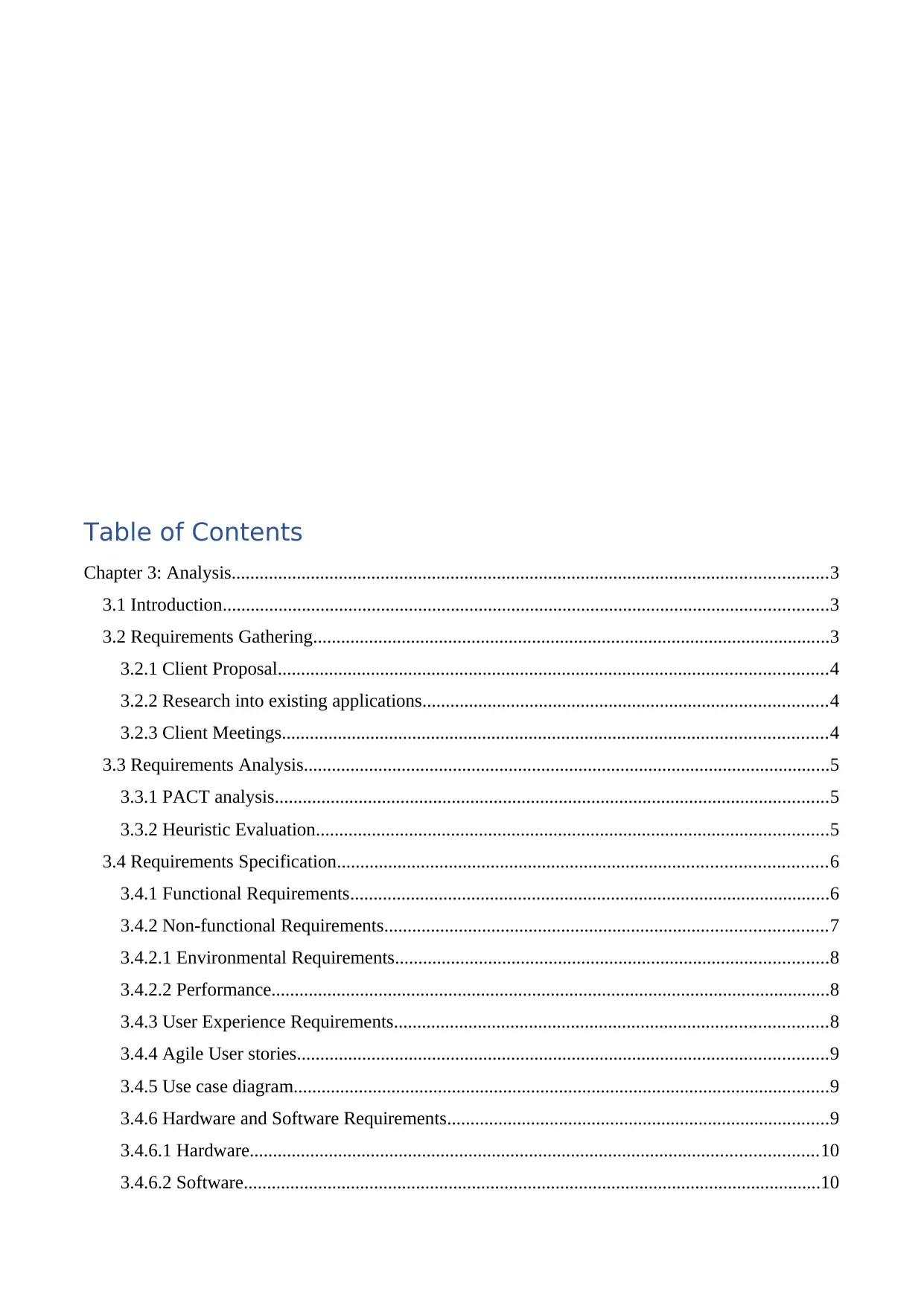
Table of Contents
Chapter 3: Analysis................................................................................................................................3
3.1 Introduction..................................................................................................................................3
3.2 Requirements Gathering...............................................................................................................3
3.2.1 Client Proposal......................................................................................................................4
3.2.2 Research into existing applications.......................................................................................4
3.2.3 Client Meetings.....................................................................................................................4
3.3 Requirements Analysis.................................................................................................................5
3.3.1 PACT analysis.......................................................................................................................5
3.3.2 Heuristic Evaluation..............................................................................................................5
3.4 Requirements Specification.........................................................................................................6
3.4.1 Functional Requirements.......................................................................................................6
3.4.2 Non-functional Requirements...............................................................................................7
3.4.2.1 Environmental Requirements.............................................................................................8
3.4.2.2 Performance........................................................................................................................8
3.4.3 User Experience Requirements.............................................................................................8
3.4.4 Agile User stories..................................................................................................................9
3.4.5 Use case diagram...................................................................................................................9
3.4.6 Hardware and Software Requirements..................................................................................9
3.4.6.1 Hardware..........................................................................................................................10
3.4.6.2 Software............................................................................................................................10
Chapter 3: Analysis................................................................................................................................3
3.1 Introduction..................................................................................................................................3
3.2 Requirements Gathering...............................................................................................................3
3.2.1 Client Proposal......................................................................................................................4
3.2.2 Research into existing applications.......................................................................................4
3.2.3 Client Meetings.....................................................................................................................4
3.3 Requirements Analysis.................................................................................................................5
3.3.1 PACT analysis.......................................................................................................................5
3.3.2 Heuristic Evaluation..............................................................................................................5
3.4 Requirements Specification.........................................................................................................6
3.4.1 Functional Requirements.......................................................................................................6
3.4.2 Non-functional Requirements...............................................................................................7
3.4.2.1 Environmental Requirements.............................................................................................8
3.4.2.2 Performance........................................................................................................................8
3.4.3 User Experience Requirements.............................................................................................8
3.4.4 Agile User stories..................................................................................................................9
3.4.5 Use case diagram...................................................................................................................9
3.4.6 Hardware and Software Requirements..................................................................................9
3.4.6.1 Hardware..........................................................................................................................10
3.4.6.2 Software............................................................................................................................10
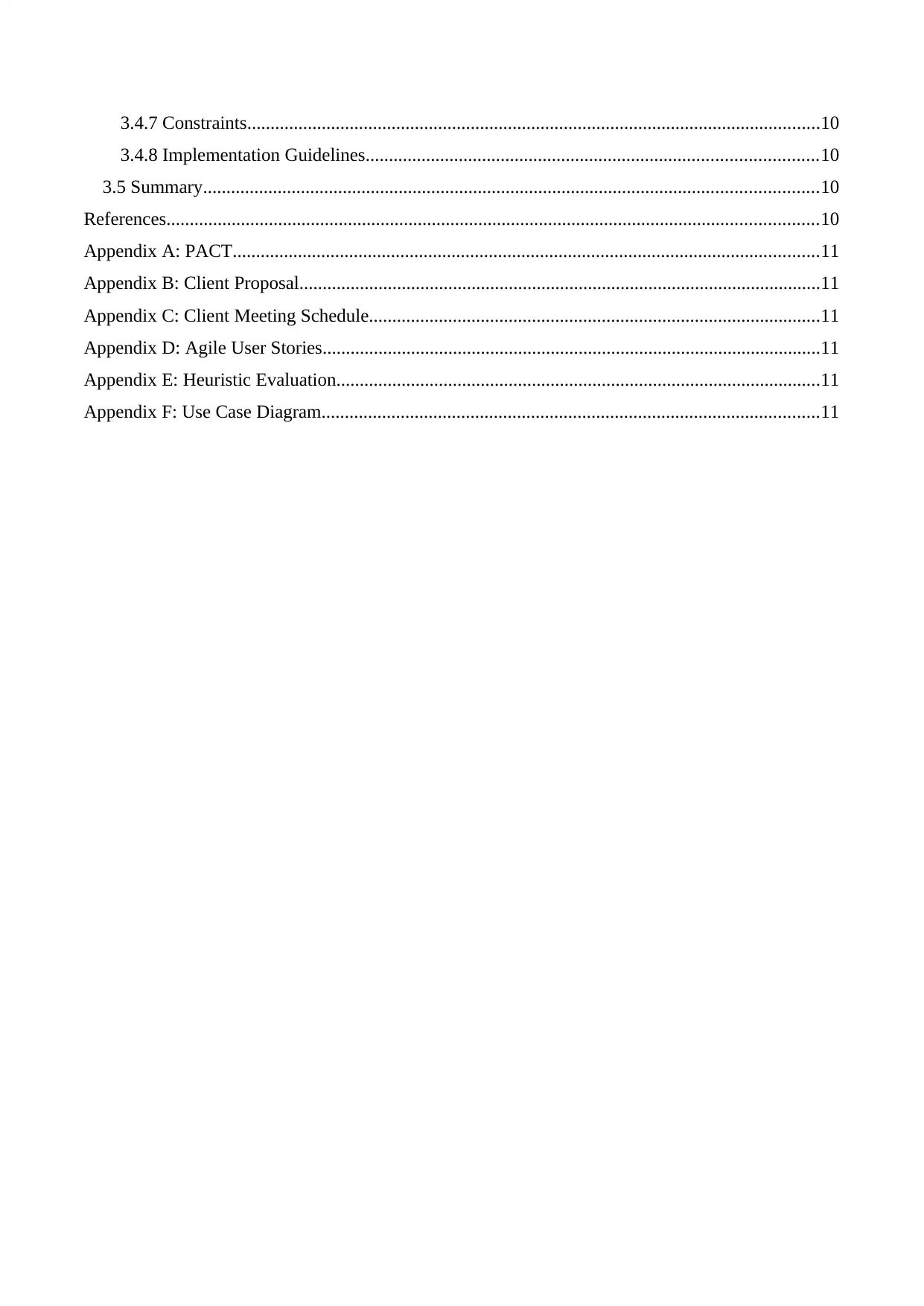
3.4.7 Constraints...........................................................................................................................10
3.4.8 Implementation Guidelines.................................................................................................10
3.5 Summary....................................................................................................................................10
References............................................................................................................................................10
Appendix A: PACT..............................................................................................................................11
Appendix B: Client Proposal................................................................................................................11
Appendix C: Client Meeting Schedule.................................................................................................11
Appendix D: Agile User Stories...........................................................................................................11
Appendix E: Heuristic Evaluation........................................................................................................11
Appendix F: Use Case Diagram...........................................................................................................11
3.4.8 Implementation Guidelines.................................................................................................10
3.5 Summary....................................................................................................................................10
References............................................................................................................................................10
Appendix A: PACT..............................................................................................................................11
Appendix B: Client Proposal................................................................................................................11
Appendix C: Client Meeting Schedule.................................................................................................11
Appendix D: Agile User Stories...........................................................................................................11
Appendix E: Heuristic Evaluation........................................................................................................11
Appendix F: Use Case Diagram...........................................................................................................11
⊘ This is a preview!⊘
Do you want full access?
Subscribe today to unlock all pages.

Trusted by 1+ million students worldwide
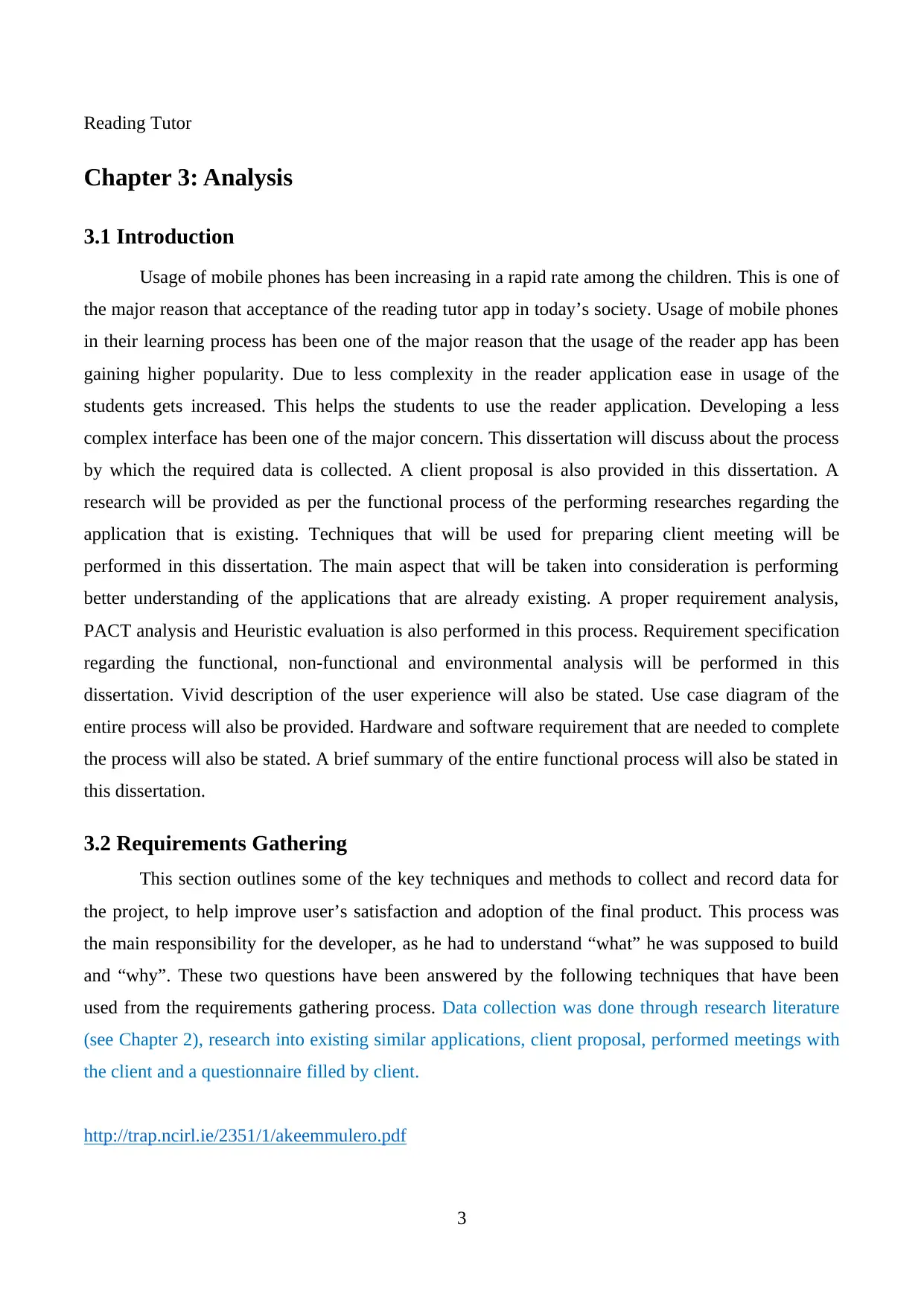
Reading Tutor
Chapter 3: Analysis
3.1 Introduction
Usage of mobile phones has been increasing in a rapid rate among the children. This is one of
the major reason that acceptance of the reading tutor app in today’s society. Usage of mobile phones
in their learning process has been one of the major reason that the usage of the reader app has been
gaining higher popularity. Due to less complexity in the reader application ease in usage of the
students gets increased. This helps the students to use the reader application. Developing a less
complex interface has been one of the major concern. This dissertation will discuss about the process
by which the required data is collected. A client proposal is also provided in this dissertation. A
research will be provided as per the functional process of the performing researches regarding the
application that is existing. Techniques that will be used for preparing client meeting will be
performed in this dissertation. The main aspect that will be taken into consideration is performing
better understanding of the applications that are already existing. A proper requirement analysis,
PACT analysis and Heuristic evaluation is also performed in this process. Requirement specification
regarding the functional, non-functional and environmental analysis will be performed in this
dissertation. Vivid description of the user experience will also be stated. Use case diagram of the
entire process will also be provided. Hardware and software requirement that are needed to complete
the process will also be stated. A brief summary of the entire functional process will also be stated in
this dissertation.
3.2 Requirements Gathering
This section outlines some of the key techniques and methods to collect and record data for
the project, to help improve user’s satisfaction and adoption of the final product. This process was
the main responsibility for the developer, as he had to understand “what” he was supposed to build
and “why”. These two questions have been answered by the following techniques that have been
used from the requirements gathering process. Data collection was done through research literature
(see Chapter 2), research into existing similar applications, client proposal, performed meetings with
the client and a questionnaire filled by client.
http://trap.ncirl.ie/2351/1/akeemmulero.pdf
3
Chapter 3: Analysis
3.1 Introduction
Usage of mobile phones has been increasing in a rapid rate among the children. This is one of
the major reason that acceptance of the reading tutor app in today’s society. Usage of mobile phones
in their learning process has been one of the major reason that the usage of the reader app has been
gaining higher popularity. Due to less complexity in the reader application ease in usage of the
students gets increased. This helps the students to use the reader application. Developing a less
complex interface has been one of the major concern. This dissertation will discuss about the process
by which the required data is collected. A client proposal is also provided in this dissertation. A
research will be provided as per the functional process of the performing researches regarding the
application that is existing. Techniques that will be used for preparing client meeting will be
performed in this dissertation. The main aspect that will be taken into consideration is performing
better understanding of the applications that are already existing. A proper requirement analysis,
PACT analysis and Heuristic evaluation is also performed in this process. Requirement specification
regarding the functional, non-functional and environmental analysis will be performed in this
dissertation. Vivid description of the user experience will also be stated. Use case diagram of the
entire process will also be provided. Hardware and software requirement that are needed to complete
the process will also be stated. A brief summary of the entire functional process will also be stated in
this dissertation.
3.2 Requirements Gathering
This section outlines some of the key techniques and methods to collect and record data for
the project, to help improve user’s satisfaction and adoption of the final product. This process was
the main responsibility for the developer, as he had to understand “what” he was supposed to build
and “why”. These two questions have been answered by the following techniques that have been
used from the requirements gathering process. Data collection was done through research literature
(see Chapter 2), research into existing similar applications, client proposal, performed meetings with
the client and a questionnaire filled by client.
http://trap.ncirl.ie/2351/1/akeemmulero.pdf
3
Paraphrase This Document
Need a fresh take? Get an instant paraphrase of this document with our AI Paraphraser
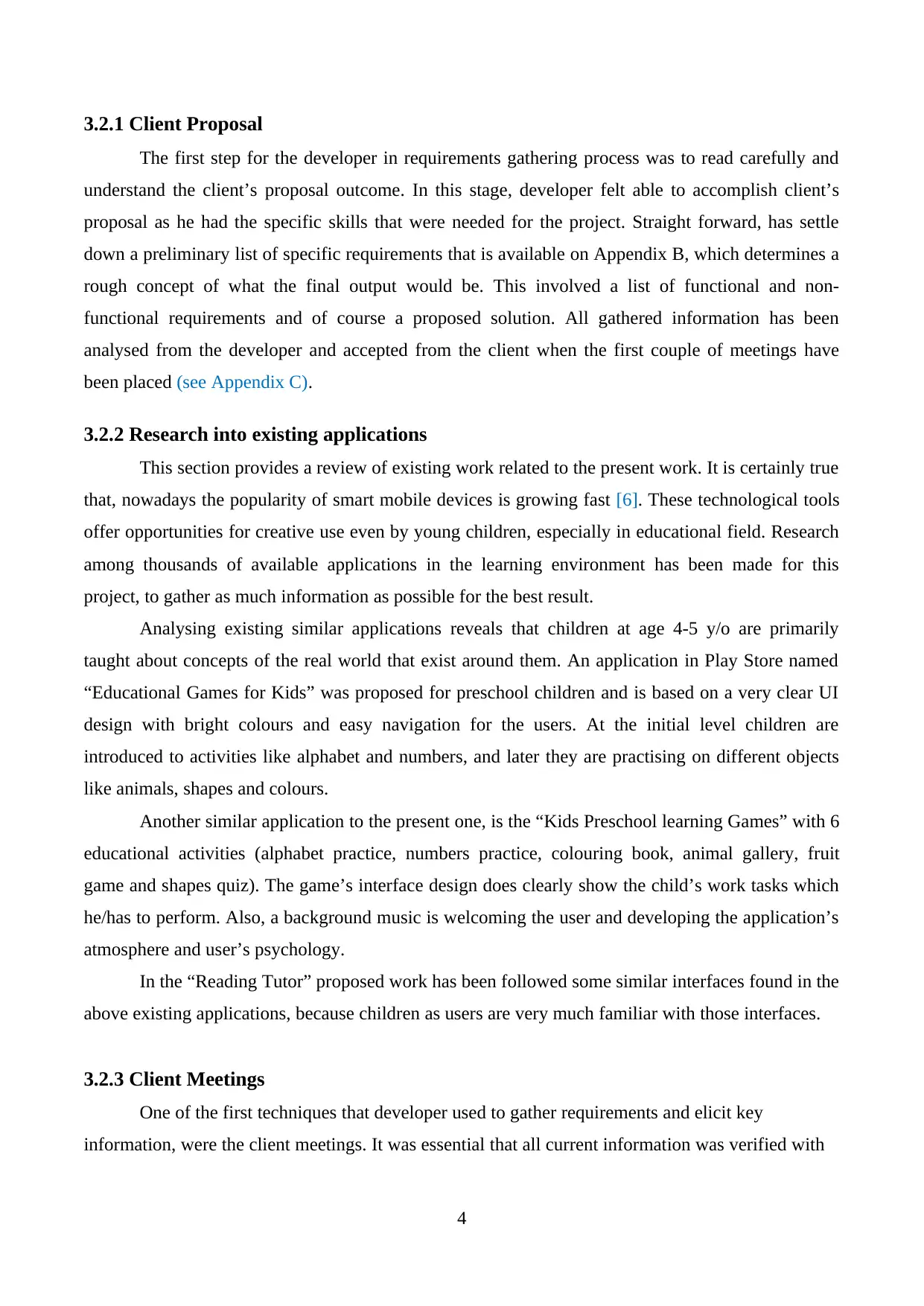
3.2.1 Client Proposal
The first step for the developer in requirements gathering process was to read carefully and
understand the client’s proposal outcome. In this stage, developer felt able to accomplish client’s
proposal as he had the specific skills that were needed for the project. Straight forward, has settle
down a preliminary list of specific requirements that is available on Appendix B, which determines a
rough concept of what the final output would be. This involved a list of functional and non-
functional requirements and of course a proposed solution. All gathered information has been
analysed from the developer and accepted from the client when the first couple of meetings have
been placed (see Appendix C).
3.2.2 Research into existing applications
This section provides a review of existing work related to the present work. It is certainly true
that, nowadays the popularity of smart mobile devices is growing fast [6]. These technological tools
offer opportunities for creative use even by young children, especially in educational field. Research
among thousands of available applications in the learning environment has been made for this
project, to gather as much information as possible for the best result.
Analysing existing similar applications reveals that children at age 4-5 y/o are primarily
taught about concepts of the real world that exist around them. An application in Play Store named
“Educational Games for Kids” was proposed for preschool children and is based on a very clear UI
design with bright colours and easy navigation for the users. At the initial level children are
introduced to activities like alphabet and numbers, and later they are practising on different objects
like animals, shapes and colours.
Another similar application to the present one, is the “Kids Preschool learning Games” with 6
educational activities (alphabet practice, numbers practice, colouring book, animal gallery, fruit
game and shapes quiz). The game’s interface design does clearly show the child’s work tasks which
he/has to perform. Also, a background music is welcoming the user and developing the application’s
atmosphere and user’s psychology.
In the “Reading Tutor” proposed work has been followed some similar interfaces found in the
above existing applications, because children as users are very much familiar with those interfaces.
3.2.3 Client Meetings
One of the first techniques that developer used to gather requirements and elicit key
information, were the client meetings. It was essential that all current information was verified with
4
The first step for the developer in requirements gathering process was to read carefully and
understand the client’s proposal outcome. In this stage, developer felt able to accomplish client’s
proposal as he had the specific skills that were needed for the project. Straight forward, has settle
down a preliminary list of specific requirements that is available on Appendix B, which determines a
rough concept of what the final output would be. This involved a list of functional and non-
functional requirements and of course a proposed solution. All gathered information has been
analysed from the developer and accepted from the client when the first couple of meetings have
been placed (see Appendix C).
3.2.2 Research into existing applications
This section provides a review of existing work related to the present work. It is certainly true
that, nowadays the popularity of smart mobile devices is growing fast [6]. These technological tools
offer opportunities for creative use even by young children, especially in educational field. Research
among thousands of available applications in the learning environment has been made for this
project, to gather as much information as possible for the best result.
Analysing existing similar applications reveals that children at age 4-5 y/o are primarily
taught about concepts of the real world that exist around them. An application in Play Store named
“Educational Games for Kids” was proposed for preschool children and is based on a very clear UI
design with bright colours and easy navigation for the users. At the initial level children are
introduced to activities like alphabet and numbers, and later they are practising on different objects
like animals, shapes and colours.
Another similar application to the present one, is the “Kids Preschool learning Games” with 6
educational activities (alphabet practice, numbers practice, colouring book, animal gallery, fruit
game and shapes quiz). The game’s interface design does clearly show the child’s work tasks which
he/has to perform. Also, a background music is welcoming the user and developing the application’s
atmosphere and user’s psychology.
In the “Reading Tutor” proposed work has been followed some similar interfaces found in the
above existing applications, because children as users are very much familiar with those interfaces.
3.2.3 Client Meetings
One of the first techniques that developer used to gather requirements and elicit key
information, were the client meetings. It was essential that all current information was verified with
4

the client to ensure the developer was heading in the right direction with the project planning and that
no time was wasted.
https://www.skylinetechnologies.com/Blog/Skyline-Blog/August-2014/10-Steps-to-Organize-and-
Facilitate-a-Successful-R
A meeting was arranged with the client where they were given the list of initial requirements
as determined by the developer based on the initial proposal they were presented. Following a
discussion with the client about the specifics of each of them, the client was able to comfortably sign
off the requirements as they were (see Appendix B).
3.3 Requirements Analysis
Following the requirements gathering process the developer was able to start the process of
determining user expectations for the proposed product before building it. This section involves all
the tasks that are conducted to identify all the user’s needs. Therefore, in the sub-sections below are
listed and analysed the tools PACT and the 10 principles of Heuristic Evaluation that help to improve
the process of the project going forward and are defined to a facilitate system design.
3.3.1 PACT analysis
An essential part of the project’s approach to guide the developer during the design process
and to bring together all the research in user’s target and scope out the variety of different people,
activities, contexts and technologies reflects the PACT analysis that includes observations supporting
this analysis (see Appendix A). As it is described in Appendix A, the first part presents the user
characteristics that developer had to concerned about when designed the mobile app. Based on that,
developer acted appropriately to design the interface in such a way that it is suitable and can be used
in a right way by targeted users. Therefore, there are performed the main goals users will want to
achieve with this product that affected developer to solve any occurring problem. The third aspect of
this analysis method is the description of the likely environment that product will be used, allowing
the developer to identify several scenarios that will be happen when user uses the app. Finally, PACT
analysis provides the type of technology will the users have and give out a clearer picture on the
design of the project’s interface especially in the mapping between the inputs and the outputs. Each
element of this analysis became helpful for the developer to build an effective product that supports
the users in learning field.
5
no time was wasted.
https://www.skylinetechnologies.com/Blog/Skyline-Blog/August-2014/10-Steps-to-Organize-and-
Facilitate-a-Successful-R
A meeting was arranged with the client where they were given the list of initial requirements
as determined by the developer based on the initial proposal they were presented. Following a
discussion with the client about the specifics of each of them, the client was able to comfortably sign
off the requirements as they were (see Appendix B).
3.3 Requirements Analysis
Following the requirements gathering process the developer was able to start the process of
determining user expectations for the proposed product before building it. This section involves all
the tasks that are conducted to identify all the user’s needs. Therefore, in the sub-sections below are
listed and analysed the tools PACT and the 10 principles of Heuristic Evaluation that help to improve
the process of the project going forward and are defined to a facilitate system design.
3.3.1 PACT analysis
An essential part of the project’s approach to guide the developer during the design process
and to bring together all the research in user’s target and scope out the variety of different people,
activities, contexts and technologies reflects the PACT analysis that includes observations supporting
this analysis (see Appendix A). As it is described in Appendix A, the first part presents the user
characteristics that developer had to concerned about when designed the mobile app. Based on that,
developer acted appropriately to design the interface in such a way that it is suitable and can be used
in a right way by targeted users. Therefore, there are performed the main goals users will want to
achieve with this product that affected developer to solve any occurring problem. The third aspect of
this analysis method is the description of the likely environment that product will be used, allowing
the developer to identify several scenarios that will be happen when user uses the app. Finally, PACT
analysis provides the type of technology will the users have and give out a clearer picture on the
design of the project’s interface especially in the mapping between the inputs and the outputs. Each
element of this analysis became helpful for the developer to build an effective product that supports
the users in learning field.
5
⊘ This is a preview!⊘
Do you want full access?
Subscribe today to unlock all pages.

Trusted by 1+ million students worldwide
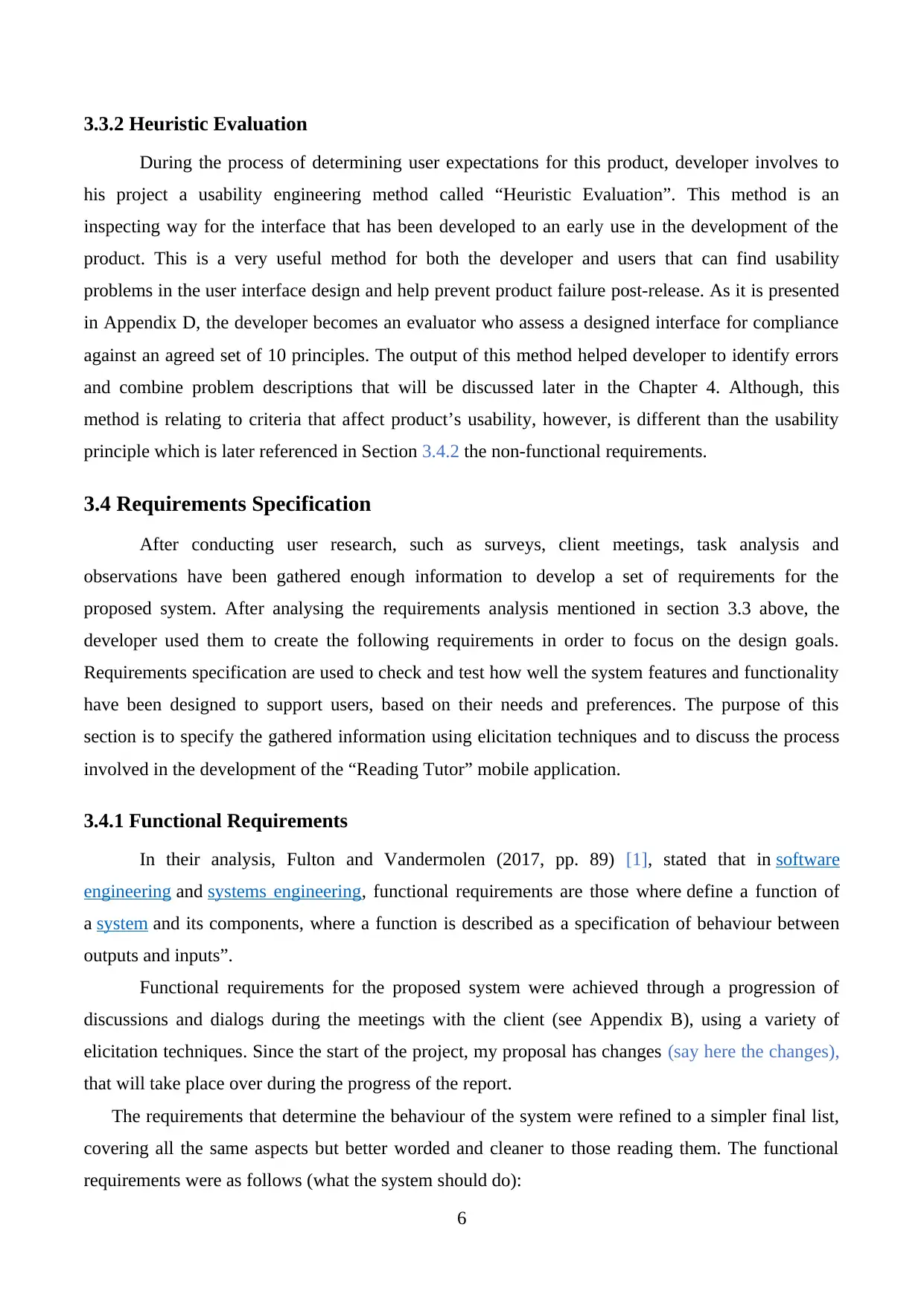
3.3.2 Heuristic Evaluation
During the process of determining user expectations for this product, developer involves to
his project a usability engineering method called “Heuristic Evaluation”. This method is an
inspecting way for the interface that has been developed to an early use in the development of the
product. This is a very useful method for both the developer and users that can find usability
problems in the user interface design and help prevent product failure post-release. As it is presented
in Appendix D, the developer becomes an evaluator who assess a designed interface for compliance
against an agreed set of 10 principles. The output of this method helped developer to identify errors
and combine problem descriptions that will be discussed later in the Chapter 4. Although, this
method is relating to criteria that affect product’s usability, however, is different than the usability
principle which is later referenced in Section 3.4.2 the non-functional requirements.
3.4 Requirements Specification
After conducting user research, such as surveys, client meetings, task analysis and
observations have been gathered enough information to develop a set of requirements for the
proposed system. After analysing the requirements analysis mentioned in section 3.3 above, the
developer used them to create the following requirements in order to focus on the design goals.
Requirements specification are used to check and test how well the system features and functionality
have been designed to support users, based on their needs and preferences. The purpose of this
section is to specify the gathered information using elicitation techniques and to discuss the process
involved in the development of the “Reading Tutor” mobile application.
3.4.1 Functional Requirements
In their analysis, Fulton and Vandermolen (2017, pp. 89) [1], stated that in software
engineering and systems engineering, functional requirements are those where define a function of
a system and its components, where a function is described as a specification of behaviour between
outputs and inputs”.
Functional requirements for the proposed system were achieved through a progression of
discussions and dialogs during the meetings with the client (see Appendix B), using a variety of
elicitation techniques. Since the start of the project, my proposal has changes (say here the changes),
that will take place over during the progress of the report.
The requirements that determine the behaviour of the system were refined to a simpler final list,
covering all the same aspects but better worded and cleaner to those reading them. The functional
requirements were as follows (what the system should do):
6
During the process of determining user expectations for this product, developer involves to
his project a usability engineering method called “Heuristic Evaluation”. This method is an
inspecting way for the interface that has been developed to an early use in the development of the
product. This is a very useful method for both the developer and users that can find usability
problems in the user interface design and help prevent product failure post-release. As it is presented
in Appendix D, the developer becomes an evaluator who assess a designed interface for compliance
against an agreed set of 10 principles. The output of this method helped developer to identify errors
and combine problem descriptions that will be discussed later in the Chapter 4. Although, this
method is relating to criteria that affect product’s usability, however, is different than the usability
principle which is later referenced in Section 3.4.2 the non-functional requirements.
3.4 Requirements Specification
After conducting user research, such as surveys, client meetings, task analysis and
observations have been gathered enough information to develop a set of requirements for the
proposed system. After analysing the requirements analysis mentioned in section 3.3 above, the
developer used them to create the following requirements in order to focus on the design goals.
Requirements specification are used to check and test how well the system features and functionality
have been designed to support users, based on their needs and preferences. The purpose of this
section is to specify the gathered information using elicitation techniques and to discuss the process
involved in the development of the “Reading Tutor” mobile application.
3.4.1 Functional Requirements
In their analysis, Fulton and Vandermolen (2017, pp. 89) [1], stated that in software
engineering and systems engineering, functional requirements are those where define a function of
a system and its components, where a function is described as a specification of behaviour between
outputs and inputs”.
Functional requirements for the proposed system were achieved through a progression of
discussions and dialogs during the meetings with the client (see Appendix B), using a variety of
elicitation techniques. Since the start of the project, my proposal has changes (say here the changes),
that will take place over during the progress of the report.
The requirements that determine the behaviour of the system were refined to a simpler final list,
covering all the same aspects but better worded and cleaner to those reading them. The functional
requirements were as follows (what the system should do):
6
Paraphrase This Document
Need a fresh take? Get an instant paraphrase of this document with our AI Paraphraser
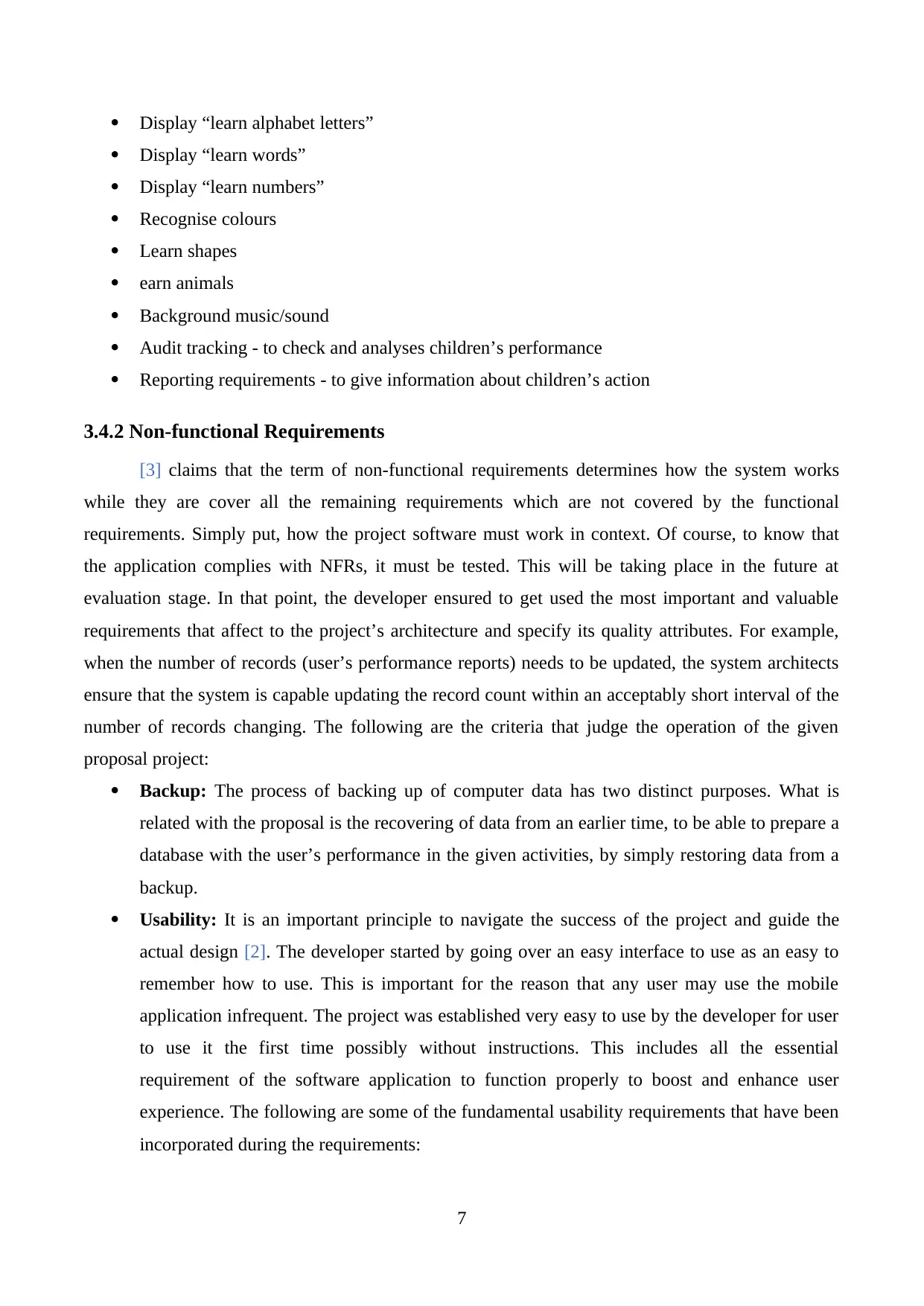
Display “learn alphabet letters”
Display “learn words”
Display “learn numbers”
Recognise colours
Learn shapes
earn animals
Background music/sound
Audit tracking - to check and analyses children’s performance
Reporting requirements - to give information about children’s action
3.4.2 Non-functional Requirements
[3] claims that the term of non-functional requirements determines how the system works
while they are cover all the remaining requirements which are not covered by the functional
requirements. Simply put, how the project software must work in context. Of course, to know that
the application complies with NFRs, it must be tested. This will be taking place in the future at
evaluation stage. In that point, the developer ensured to get used the most important and valuable
requirements that affect to the project’s architecture and specify its quality attributes. For example,
when the number of records (user’s performance reports) needs to be updated, the system architects
ensure that the system is capable updating the record count within an acceptably short interval of the
number of records changing. The following are the criteria that judge the operation of the given
proposal project:
Backup: The process of backing up of computer data has two distinct purposes. What is
related with the proposal is the recovering of data from an earlier time, to be able to prepare a
database with the user’s performance in the given activities, by simply restoring data from a
backup.
Usability: It is an important principle to navigate the success of the project and guide the
actual design [2]. The developer started by going over an easy interface to use as an easy to
remember how to use. This is important for the reason that any user may use the mobile
application infrequent. The project was established very easy to use by the developer for user
to use it the first time possibly without instructions. This includes all the essential
requirement of the software application to function properly to boost and enhance user
experience. The following are some of the fundamental usability requirements that have been
incorporated during the requirements:
7
Display “learn words”
Display “learn numbers”
Recognise colours
Learn shapes
earn animals
Background music/sound
Audit tracking - to check and analyses children’s performance
Reporting requirements - to give information about children’s action
3.4.2 Non-functional Requirements
[3] claims that the term of non-functional requirements determines how the system works
while they are cover all the remaining requirements which are not covered by the functional
requirements. Simply put, how the project software must work in context. Of course, to know that
the application complies with NFRs, it must be tested. This will be taking place in the future at
evaluation stage. In that point, the developer ensured to get used the most important and valuable
requirements that affect to the project’s architecture and specify its quality attributes. For example,
when the number of records (user’s performance reports) needs to be updated, the system architects
ensure that the system is capable updating the record count within an acceptably short interval of the
number of records changing. The following are the criteria that judge the operation of the given
proposal project:
Backup: The process of backing up of computer data has two distinct purposes. What is
related with the proposal is the recovering of data from an earlier time, to be able to prepare a
database with the user’s performance in the given activities, by simply restoring data from a
backup.
Usability: It is an important principle to navigate the success of the project and guide the
actual design [2]. The developer started by going over an easy interface to use as an easy to
remember how to use. This is important for the reason that any user may use the mobile
application infrequent. The project was established very easy to use by the developer for user
to use it the first time possibly without instructions. This includes all the essential
requirement of the software application to function properly to boost and enhance user
experience. The following are some of the fundamental usability requirements that have been
incorporated during the requirements:
7

o Efficiency of use: The usability of the proposed system is very easy to use, and goals
are easy to accomplish quickly and with few or no user errors. User interface enables
users to interact with the application with or no instructions that are given in a
categorised section.
o Learnability: The proposed mobile application has been developed in a way to
improve user learnability and knowledge with access to various reading exercises,
producing and analysing user’s performance and make appropriate reports.
o Attractiveness: The interface of the application is easy to learn and navigate and
allows the user to interact easy with features, content and functions. The developer
has been developed visible buttons and headings among the so can be simple to
understand.
o Operability: The “Reading Tutor” mobile application is supported by Android
platform which is compatible with smartphone and tablet devices.
3.4.2.1 Environmental Requirements
In order to develop an effective mobile learning application for young children, developer
considered quality requirements enhancing the learner’s needs. Following show the most essential
environmental requirements such as:
The user must have a smartphone powered by Android operating system.
The mobile device must be capable of connecting to the internet/Wi-Fi.
The user must have a mobile device that allow him/her to download the app from the online
store (Play Store).
3.4.3 User Experience Requirements
It is certainly true that, the background of a good and successful mobile application is the
quality of its user experience (UX) [4]. According to [5], it includes a person’s perceptions of system
aspects such as utility, ease of use and efficiency. So, developer considered user experience
requirements to be an essential component of product strategy, as a result user’s needs and
preferences for the interface design are supported to the given mobile application so that it provides
to the users an enjoyable experience and the means to complete their activities goals with ease. The
developer enhanced user’s experience by adding elements of delight to user interactions and
language, as those are listed below:
Prerequisites: see Appendix C.
8
are easy to accomplish quickly and with few or no user errors. User interface enables
users to interact with the application with or no instructions that are given in a
categorised section.
o Learnability: The proposed mobile application has been developed in a way to
improve user learnability and knowledge with access to various reading exercises,
producing and analysing user’s performance and make appropriate reports.
o Attractiveness: The interface of the application is easy to learn and navigate and
allows the user to interact easy with features, content and functions. The developer
has been developed visible buttons and headings among the so can be simple to
understand.
o Operability: The “Reading Tutor” mobile application is supported by Android
platform which is compatible with smartphone and tablet devices.
3.4.2.1 Environmental Requirements
In order to develop an effective mobile learning application for young children, developer
considered quality requirements enhancing the learner’s needs. Following show the most essential
environmental requirements such as:
The user must have a smartphone powered by Android operating system.
The mobile device must be capable of connecting to the internet/Wi-Fi.
The user must have a mobile device that allow him/her to download the app from the online
store (Play Store).
3.4.3 User Experience Requirements
It is certainly true that, the background of a good and successful mobile application is the
quality of its user experience (UX) [4]. According to [5], it includes a person’s perceptions of system
aspects such as utility, ease of use and efficiency. So, developer considered user experience
requirements to be an essential component of product strategy, as a result user’s needs and
preferences for the interface design are supported to the given mobile application so that it provides
to the users an enjoyable experience and the means to complete their activities goals with ease. The
developer enhanced user’s experience by adding elements of delight to user interactions and
language, as those are listed below:
Prerequisites: see Appendix C.
8
⊘ This is a preview!⊘
Do you want full access?
Subscribe today to unlock all pages.

Trusted by 1+ million students worldwide
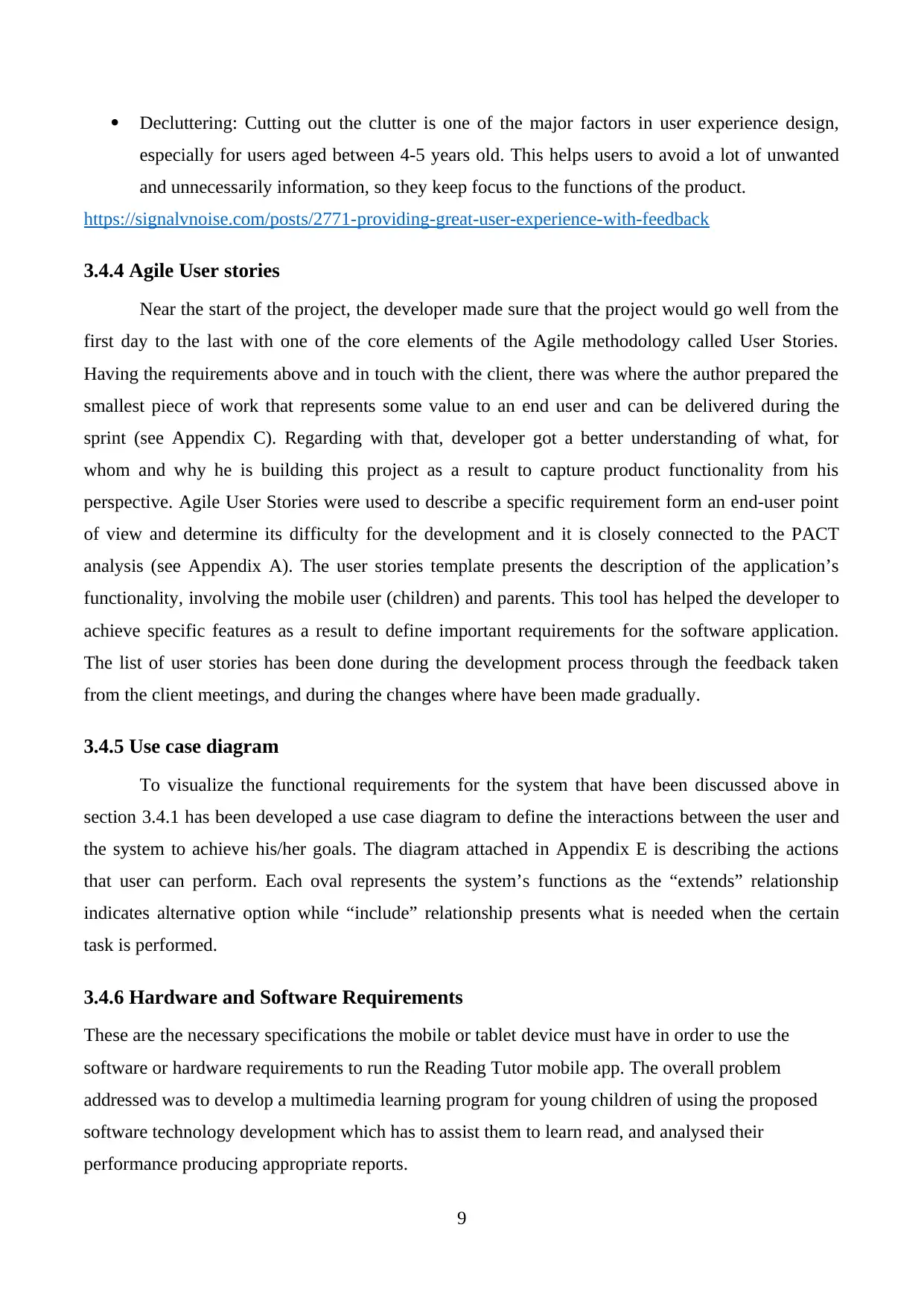
Decluttering: Cutting out the clutter is one of the major factors in user experience design,
especially for users aged between 4-5 years old. This helps users to avoid a lot of unwanted
and unnecessarily information, so they keep focus to the functions of the product.
https://signalvnoise.com/posts/2771-providing-great-user-experience-with-feedback
3.4.4 Agile User stories
Near the start of the project, the developer made sure that the project would go well from the
first day to the last with one of the core elements of the Agile methodology called User Stories.
Having the requirements above and in touch with the client, there was where the author prepared the
smallest piece of work that represents some value to an end user and can be delivered during the
sprint (see Appendix C). Regarding with that, developer got a better understanding of what, for
whom and why he is building this project as a result to capture product functionality from his
perspective. Agile User Stories were used to describe a specific requirement form an end-user point
of view and determine its difficulty for the development and it is closely connected to the PACT
analysis (see Appendix A). The user stories template presents the description of the application’s
functionality, involving the mobile user (children) and parents. This tool has helped the developer to
achieve specific features as a result to define important requirements for the software application.
The list of user stories has been done during the development process through the feedback taken
from the client meetings, and during the changes where have been made gradually.
3.4.5 Use case diagram
To visualize the functional requirements for the system that have been discussed above in
section 3.4.1 has been developed a use case diagram to define the interactions between the user and
the system to achieve his/her goals. The diagram attached in Appendix E is describing the actions
that user can perform. Each oval represents the system’s functions as the “extends” relationship
indicates alternative option while “include” relationship presents what is needed when the certain
task is performed.
3.4.6 Hardware and Software Requirements
These are the necessary specifications the mobile or tablet device must have in order to use the
software or hardware requirements to run the Reading Tutor mobile app. The overall problem
addressed was to develop a multimedia learning program for young children of using the proposed
software technology development which has to assist them to learn read, and analysed their
performance producing appropriate reports.
9
especially for users aged between 4-5 years old. This helps users to avoid a lot of unwanted
and unnecessarily information, so they keep focus to the functions of the product.
https://signalvnoise.com/posts/2771-providing-great-user-experience-with-feedback
3.4.4 Agile User stories
Near the start of the project, the developer made sure that the project would go well from the
first day to the last with one of the core elements of the Agile methodology called User Stories.
Having the requirements above and in touch with the client, there was where the author prepared the
smallest piece of work that represents some value to an end user and can be delivered during the
sprint (see Appendix C). Regarding with that, developer got a better understanding of what, for
whom and why he is building this project as a result to capture product functionality from his
perspective. Agile User Stories were used to describe a specific requirement form an end-user point
of view and determine its difficulty for the development and it is closely connected to the PACT
analysis (see Appendix A). The user stories template presents the description of the application’s
functionality, involving the mobile user (children) and parents. This tool has helped the developer to
achieve specific features as a result to define important requirements for the software application.
The list of user stories has been done during the development process through the feedback taken
from the client meetings, and during the changes where have been made gradually.
3.4.5 Use case diagram
To visualize the functional requirements for the system that have been discussed above in
section 3.4.1 has been developed a use case diagram to define the interactions between the user and
the system to achieve his/her goals. The diagram attached in Appendix E is describing the actions
that user can perform. Each oval represents the system’s functions as the “extends” relationship
indicates alternative option while “include” relationship presents what is needed when the certain
task is performed.
3.4.6 Hardware and Software Requirements
These are the necessary specifications the mobile or tablet device must have in order to use the
software or hardware requirements to run the Reading Tutor mobile app. The overall problem
addressed was to develop a multimedia learning program for young children of using the proposed
software technology development which has to assist them to learn read, and analysed their
performance producing appropriate reports.
9
Paraphrase This Document
Need a fresh take? Get an instant paraphrase of this document with our AI Paraphraser
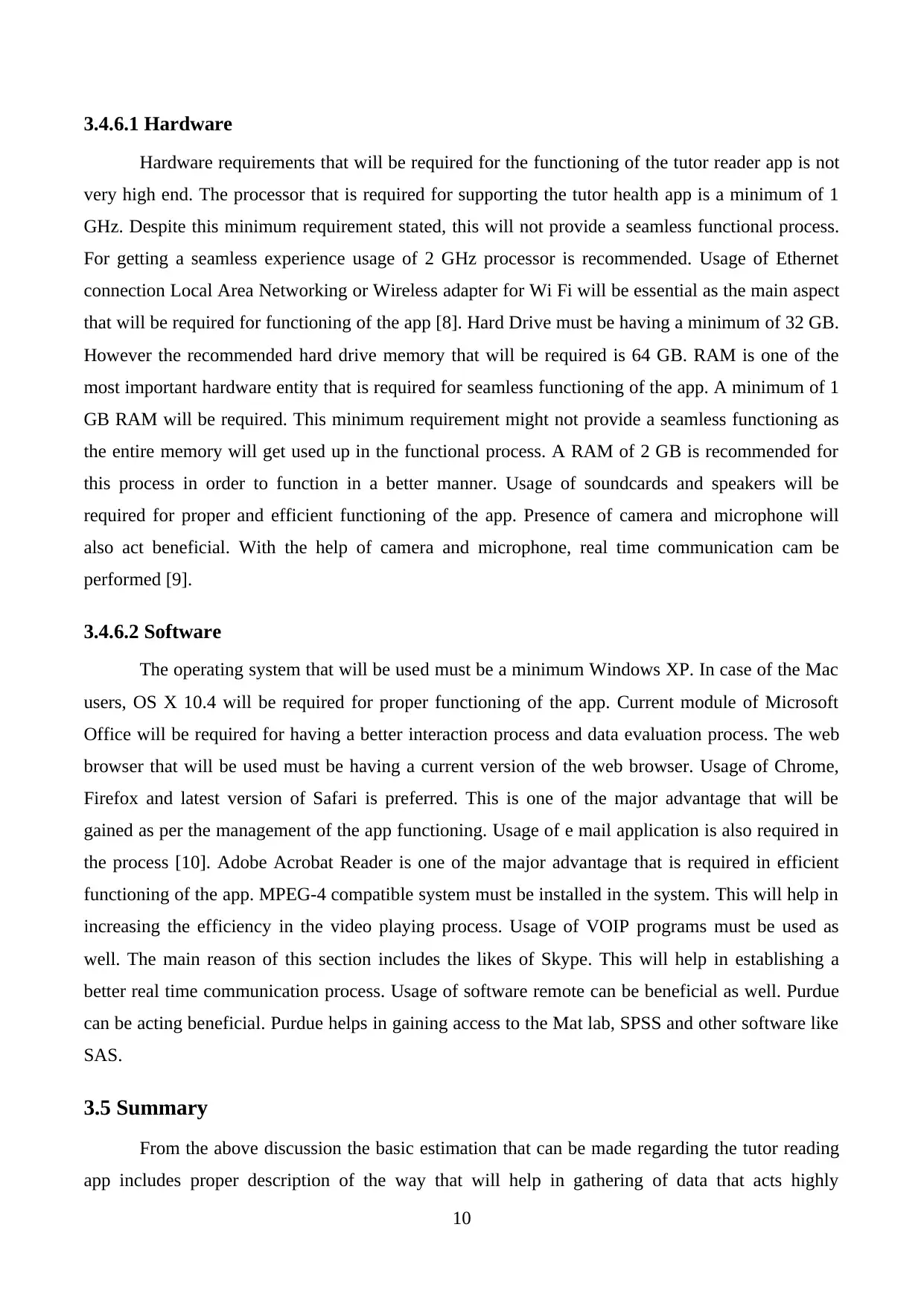
3.4.6.1 Hardware
Hardware requirements that will be required for the functioning of the tutor reader app is not
very high end. The processor that is required for supporting the tutor health app is a minimum of 1
GHz. Despite this minimum requirement stated, this will not provide a seamless functional process.
For getting a seamless experience usage of 2 GHz processor is recommended. Usage of Ethernet
connection Local Area Networking or Wireless adapter for Wi Fi will be essential as the main aspect
that will be required for functioning of the app [8]. Hard Drive must be having a minimum of 32 GB.
However the recommended hard drive memory that will be required is 64 GB. RAM is one of the
most important hardware entity that is required for seamless functioning of the app. A minimum of 1
GB RAM will be required. This minimum requirement might not provide a seamless functioning as
the entire memory will get used up in the functional process. A RAM of 2 GB is recommended for
this process in order to function in a better manner. Usage of soundcards and speakers will be
required for proper and efficient functioning of the app. Presence of camera and microphone will
also act beneficial. With the help of camera and microphone, real time communication cam be
performed [9].
3.4.6.2 Software
The operating system that will be used must be a minimum Windows XP. In case of the Mac
users, OS X 10.4 will be required for proper functioning of the app. Current module of Microsoft
Office will be required for having a better interaction process and data evaluation process. The web
browser that will be used must be having a current version of the web browser. Usage of Chrome,
Firefox and latest version of Safari is preferred. This is one of the major advantage that will be
gained as per the management of the app functioning. Usage of e mail application is also required in
the process [10]. Adobe Acrobat Reader is one of the major advantage that is required in efficient
functioning of the app. MPEG-4 compatible system must be installed in the system. This will help in
increasing the efficiency in the video playing process. Usage of VOIP programs must be used as
well. The main reason of this section includes the likes of Skype. This will help in establishing a
better real time communication process. Usage of software remote can be beneficial as well. Purdue
can be acting beneficial. Purdue helps in gaining access to the Mat lab, SPSS and other software like
SAS.
3.5 Summary
From the above discussion the basic estimation that can be made regarding the tutor reading
app includes proper description of the way that will help in gathering of data that acts highly
10
Hardware requirements that will be required for the functioning of the tutor reader app is not
very high end. The processor that is required for supporting the tutor health app is a minimum of 1
GHz. Despite this minimum requirement stated, this will not provide a seamless functional process.
For getting a seamless experience usage of 2 GHz processor is recommended. Usage of Ethernet
connection Local Area Networking or Wireless adapter for Wi Fi will be essential as the main aspect
that will be required for functioning of the app [8]. Hard Drive must be having a minimum of 32 GB.
However the recommended hard drive memory that will be required is 64 GB. RAM is one of the
most important hardware entity that is required for seamless functioning of the app. A minimum of 1
GB RAM will be required. This minimum requirement might not provide a seamless functioning as
the entire memory will get used up in the functional process. A RAM of 2 GB is recommended for
this process in order to function in a better manner. Usage of soundcards and speakers will be
required for proper and efficient functioning of the app. Presence of camera and microphone will
also act beneficial. With the help of camera and microphone, real time communication cam be
performed [9].
3.4.6.2 Software
The operating system that will be used must be a minimum Windows XP. In case of the Mac
users, OS X 10.4 will be required for proper functioning of the app. Current module of Microsoft
Office will be required for having a better interaction process and data evaluation process. The web
browser that will be used must be having a current version of the web browser. Usage of Chrome,
Firefox and latest version of Safari is preferred. This is one of the major advantage that will be
gained as per the management of the app functioning. Usage of e mail application is also required in
the process [10]. Adobe Acrobat Reader is one of the major advantage that is required in efficient
functioning of the app. MPEG-4 compatible system must be installed in the system. This will help in
increasing the efficiency in the video playing process. Usage of VOIP programs must be used as
well. The main reason of this section includes the likes of Skype. This will help in establishing a
better real time communication process. Usage of software remote can be beneficial as well. Purdue
can be acting beneficial. Purdue helps in gaining access to the Mat lab, SPSS and other software like
SAS.
3.5 Summary
From the above discussion the basic estimation that can be made regarding the tutor reading
app includes proper description of the way that will help in gathering of data that acts highly
10
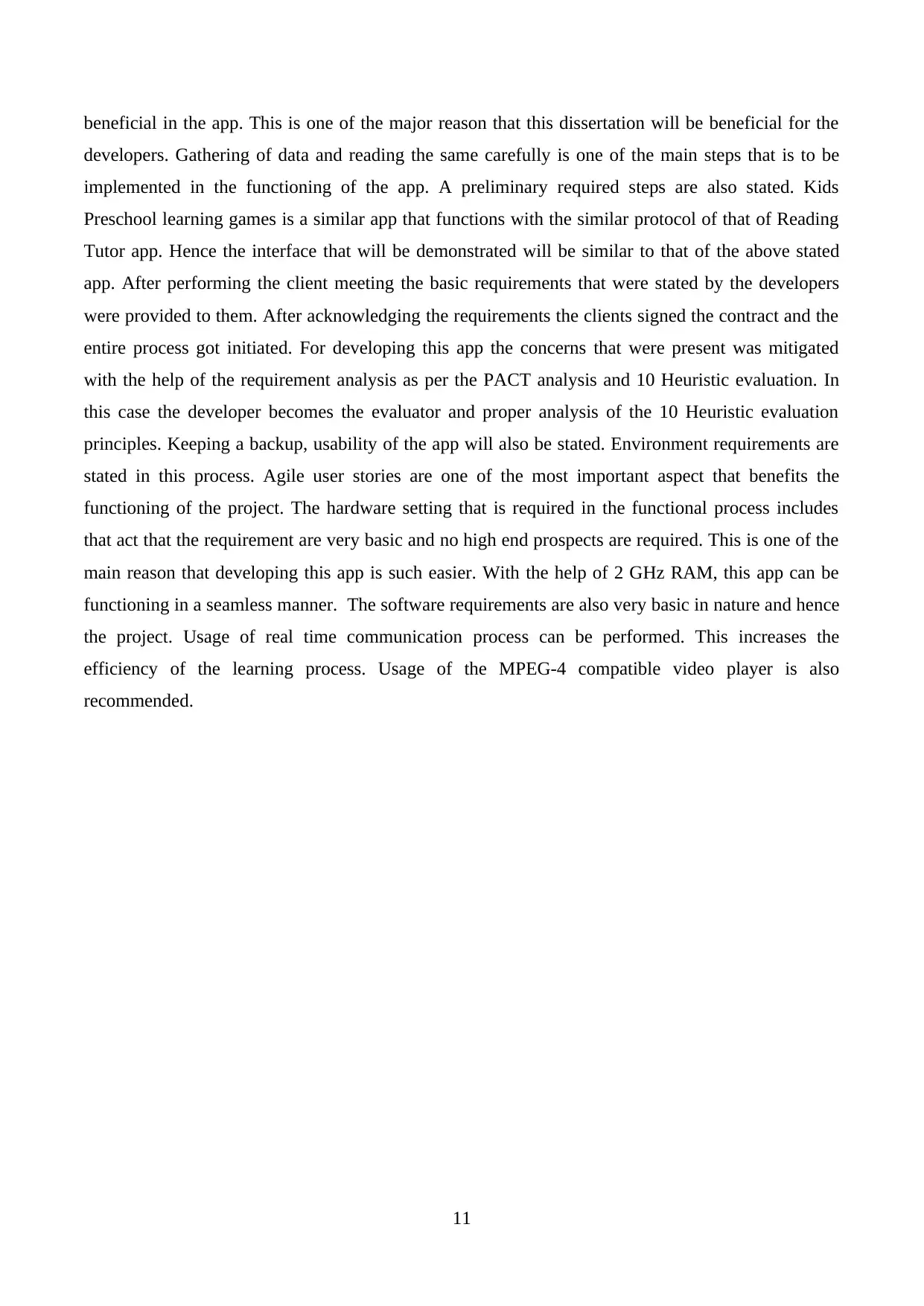
beneficial in the app. This is one of the major reason that this dissertation will be beneficial for the
developers. Gathering of data and reading the same carefully is one of the main steps that is to be
implemented in the functioning of the app. A preliminary required steps are also stated. Kids
Preschool learning games is a similar app that functions with the similar protocol of that of Reading
Tutor app. Hence the interface that will be demonstrated will be similar to that of the above stated
app. After performing the client meeting the basic requirements that were stated by the developers
were provided to them. After acknowledging the requirements the clients signed the contract and the
entire process got initiated. For developing this app the concerns that were present was mitigated
with the help of the requirement analysis as per the PACT analysis and 10 Heuristic evaluation. In
this case the developer becomes the evaluator and proper analysis of the 10 Heuristic evaluation
principles. Keeping a backup, usability of the app will also be stated. Environment requirements are
stated in this process. Agile user stories are one of the most important aspect that benefits the
functioning of the project. The hardware setting that is required in the functional process includes
that act that the requirement are very basic and no high end prospects are required. This is one of the
main reason that developing this app is such easier. With the help of 2 GHz RAM, this app can be
functioning in a seamless manner. The software requirements are also very basic in nature and hence
the project. Usage of real time communication process can be performed. This increases the
efficiency of the learning process. Usage of the MPEG-4 compatible video player is also
recommended.
11
developers. Gathering of data and reading the same carefully is one of the main steps that is to be
implemented in the functioning of the app. A preliminary required steps are also stated. Kids
Preschool learning games is a similar app that functions with the similar protocol of that of Reading
Tutor app. Hence the interface that will be demonstrated will be similar to that of the above stated
app. After performing the client meeting the basic requirements that were stated by the developers
were provided to them. After acknowledging the requirements the clients signed the contract and the
entire process got initiated. For developing this app the concerns that were present was mitigated
with the help of the requirement analysis as per the PACT analysis and 10 Heuristic evaluation. In
this case the developer becomes the evaluator and proper analysis of the 10 Heuristic evaluation
principles. Keeping a backup, usability of the app will also be stated. Environment requirements are
stated in this process. Agile user stories are one of the most important aspect that benefits the
functioning of the project. The hardware setting that is required in the functional process includes
that act that the requirement are very basic and no high end prospects are required. This is one of the
main reason that developing this app is such easier. With the help of 2 GHz RAM, this app can be
functioning in a seamless manner. The software requirements are also very basic in nature and hence
the project. Usage of real time communication process can be performed. This increases the
efficiency of the learning process. Usage of the MPEG-4 compatible video player is also
recommended.
11
⊘ This is a preview!⊘
Do you want full access?
Subscribe today to unlock all pages.

Trusted by 1+ million students worldwide
1 out of 14
Related Documents
Your All-in-One AI-Powered Toolkit for Academic Success.
+13062052269
info@desklib.com
Available 24*7 on WhatsApp / Email
![[object Object]](/_next/static/media/star-bottom.7253800d.svg)
Unlock your academic potential
Copyright © 2020–2025 A2Z Services. All Rights Reserved. Developed and managed by ZUCOL.




